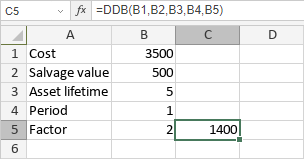DDB Function
The DDB function is one of the financial functions. It is used to calculate the depreciation of an asset for a specified accounting period using the double-declining balance method.
Syntax
DDB(cost, salvage, life, period, [factor])
The DDB function has the following arguments:
| Argument | Description |
|---|---|
| cost | The cost of the asset. |
| salvage | The salvage value of the asset at the end of its lifetime. |
| life | The total number of the periods within the asset lifetime. |
| period | The period you wish to calculate depreciation for. The value must be expressed in the same units as life. |
| factor | The rate at which the balance declines. It is an optional argument. If it is omitted, the function will assume factor to be 2. |
Notes
All the values must be positive numbers.
How to apply the DDB function.
Examples
The figure below displays the result returned by the DDB function.
